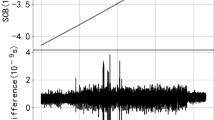Abstract
Real-time users cannot carry out real-time precise point positioning (RT-PPP) because they cannot receive real-time service (RTS) products from the international GPS service (IGS) in the case of interrupted communication. We address this issue by introducing a stable particle swarm optimized wavelet neural network (PSOWNN) to predict the short-term satellite clock bias in real time accurately. The predicted sequences of the new model are compared with those of the conventional linear polynomial, quadratic polynomial, gray system (GM (1,1)), and Kalman filter models. The results show that the accuracy of the proposed model is better than that of these four models. The average prediction accuracy of the 30-min and 60-min forecasting has improved by approximately (79.3, 82.4, 79.1, 97.4) % and (97.4, 82.9, 87.7, 98.9) % and is better than 0.3 ns during 30-min and 1-h forecasting. The RTS products can thus be replaced with the short-term clock products predicted by the PSOWNN model to meet the precision requirements of RT-PPP.






Similar content being viewed by others
Data availability
The experimental data in the manuscript are all public data and can be downloaded from the IGS Web site (cddis.nasa.gov/gps/products/rtpp).
References
Alireza ALFI (2011) PSO with adaptive mutation and inertia weight and its application in parameter estimation of dynamic systems. Acta Autom Sin 37(5):541–549
Asimakopoulou GE, Kontargyri VT, Tsekouras GJ, Stathopulos IA, Gonos IF (2009) Artificial neural network optimization methodology for the estimation of the critical flashover voltage on insulators. IET Sci Meas Technol 3(1):90–104
Ge YH, Xiong YL, Chen ZS, Chen HB, Long JL (2015) Prediction method of GPS precipitation based on wavelet neural network. Sci Surv Mapp 40(9):28–32
Guo HR (2006) Study on the analysis theories and algorithms of the time and frequency characterization for atomic clocks of navigation satellite. Dissertation, Information and Engineering University, Zhengzhou
Hou RM, Liu RZ, Gao Q, Wang L (2014) Application of particle swarm optimization wavelet neural network on AC servo system. J Syst Simul 26(4):881–886
Huang GW, Zhang Q, Xu GC (2014) Real-time clock offset prediction with an improved model. GPS Solut 18(1):95–104
Ji YJ, Lu JW, Chen XS, Hu B (2016) Prediction model of bus arrival time based on particle swarm optimization and wavelet neural network. J Transp Syst Eng Inf Technol 16(3):60–66
Jin A, Voratas K (2009) A particle swarm optimization for the vehicle routing problem with simultaneous pickup and delivery. Comput Oper Res 36(5):1693–1702
Jonsson P, Eklundh L (2002) Seasonality extraction by function fitting to time-series of satellite sensor data. IEEE Trans Geosci Remote Sens 40(8):1824–1832
Kennedy J, Eberhart R C (1995) Particle swarm optimization. In: Proceeding of IEEE international conference on neural networks, pp 1942–1948
Li X (2009) Comparing the Kalman filter with a Monte Carlo based artificial neural network in the INS/GPS vector gravimetric system. J Geodesy 83(9):797–804
Lin XJ, Guo F, Lv CX, Xu Y (2010) Impacts of sampling rates of IGS satellite clock on convergence of precise point positioning. Geom Inf Sci Wuhan Univ 35(6):683–686
Nie P, Chen X, Xu T, Sun BL (2011) State recognition of tool wear based on wavelet neural network. J Beijing Univ Aeronaut Astronaut 37(1):106–109
Nie ZX, Gao Y, Wang ZJ, Ji SY, Yang ZH (2018) An approach to GPS clock prediction for real-time PPP during outages of RTS stream. GPS Solut 22(1):14–20
Wang QJ (2007) Studies on the prediction of earth’s variable rotation by artificial neural networks. Shanghai: Dissertation, Astronomical Observatory, Chinese Academy of Sciences, Shanghai
Wang Q, Wang P H, Su Z G (2013) A hybrid search strategy-based particles swarm optimization algorithm. In: IEEE conference on industrial electronics and applications, pp 301–306
Wang YP, Lu ZP, Chen ZS, Cui Y (2013b) Research the algorithm of wavelet neural network to predict satellite clock bias. Acta Geodaetica Cartogr Sin 42(3):323–330
Wang YP, Lv ZP, Cui Y, Lv H, Li LY (2014) Predicting navigation satellite clock bias using a genetic wavelet neural network. Geom Inf Sci Wuhan Univ 39(7):809–814
Wang YP, Lu ZP, Chen ZS, Huang LY, Li LY, Gong XC (2016) A new data preprocessing method for satellite clock bias and its application in WNN to predict medium-term and long-term clock bias. Geom Inf Sci Wuhan Univ 41(3):376–378
Wang YP, Lu ZP, Qu YY, Li LY, Wang N (2017) Improving prediction performance of GPS satellite clock bias based on wavelet neural network. GPS Solut 21(3):523–534
Wang X, Chai HZ, Wang C (2020) T-S fuzzy neural network to predict satellite clock bias. Acta Geodaetica Cartogr Sin 49(5):580–587
Xiong HW, Cheng WX, Zhang HT (2017) Wavelet neural network prediction for satellite in single difference. Sci Surv Mapp 42(9):9–14
Xu LQ, Liu SY (2013) Study of short-term water quality prediction model based on wavelet neural network. Math Comput Model 58(3–4):807–813
Xu B, Wang Y, Yang X (2013) Navigation satellite clock error prediction based on functional network. Neural Process Lett 38(2):305–320
Yin CY, Sun FJ, Fan JQ, Wang YW (2017) Fault diagnosis method of photovoltaic module based on particle swarm optimized wavelet neural network. J Comput Appl 37(3):106–109
Zhang XH, Guo F, Li XX (2010) Impact of sample rate of IGS satellite clock on precise point positioning. Geom Inf Sci Wuhan Univ 35(2):152–155
Author information
Authors and Affiliations
Corresponding author
Additional information
Publisher's Note
Springer Nature remains neutral with regard to jurisdictional claims in published maps and institutional affiliations.
Rights and permissions
About this article
Cite this article
Wang, X., Chai, H. & Wang, C. A high-precision short-term prediction method with stable performance for satellite clock bias. GPS Solut 24, 105 (2020). https://doi.org/10.1007/s10291-020-01019-5
Received:
Accepted:
Published:
DOI: https://doi.org/10.1007/s10291-020-01019-5




